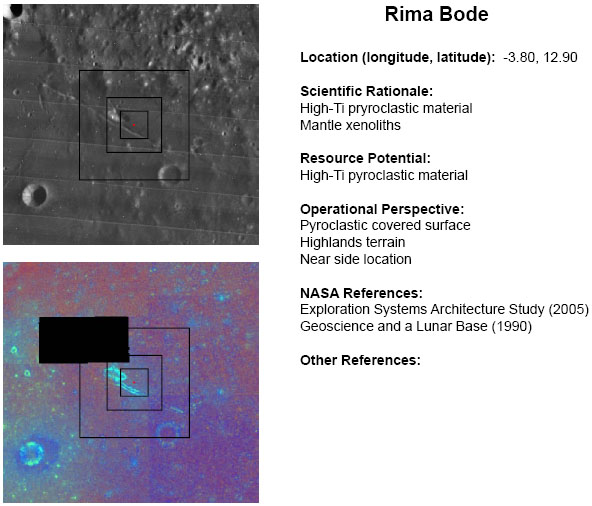RoI - Rima Bode
Contents
Rima Bode
(Tier 1 [/Cx35 Region of Interest] for Constellation Program)
Official NASA Overview

source: NASA Cx-LROC Tier 1 Targets (PDF); see expanded details below
Table of Contents
[#Rima Bode Rima Bode]
[#Rima Bode-Official NASA Overview Official NASA Overview]
[#Rima Bode-Scientific Rationale Scientific Rationale]
[#Rima Bode-Scientific Rationale-High-Ti pyroclastic material High-Ti pyroclastic material]
[#Rima Bode-Scientific Rationale-Mantle xenoliths Mantle xenoliths]
[#Rima Bode-Scientific Rationale-NASA References NASA References]
[#Rima Bode-Additional Information Additional Information]
[#Rima Bode-LROC Links LROC Links]
[#Rima Bode-LPOD Articles LPOD Articles]
[#Rima Bode-General Bibliography General Bibliography]
Scientific Rationale
High-Ti pyroclastic material
The Rima Bode II region (shown above) is distinguished by having some of the largest, and darkest, [/pyroclastic pyroclastic] deposits (volcanic ash) on the Moon. Such Dark Mantle Deposits (DMDs) are usually located along the edges of mare basin borders, and result from volcanic fire fountains spewing out volatile-rich basaltic magma from deep within the mantle. The deposits erupt through numerous vents under a very high-driving pressure, which then fall back onto the lunar surface as a 'mist' of solid glass beads. Because these glass beads are believed to have been largely unmodified from their original chemical composition during eruption, their potential to address major questions about the bulk composition of the Moon are very important.
The pyroclastic deposits around Rima Bode II are [/Stratigraphy Imbrium] in age (3.85 - 3.15 bn years), and lie superimposed predominantly on highlands between [/Sinus%20Aestuum Sinus Aestuum] and [/Mare%20Vaporum Mare Vaporum]. They consist almost entirely of ilmenite-rich, black volcanic glasses high in Titanium (Hi-Ti), and spectral analyses of the region suggest a distinct mineralogical mixed composition between volcanic glasses and black beads. The deposits -- consisting of 10-20 meters of loose, unconsolidated, fine-grained material that cover an area of 6,620 km^2 -- are considered the best example of primitive volcanic material on the Moon. Their occurence in the region can lead to a better description of local geological conditions during formation; giving data on volume, distribution, and eruptive styles in an early volcanism period. - JohnMoore2 JohnMoore2
- Gaddisi, L.R. Et Al (2009). Lunar Reconnaissance Orbiter Science Targeting Meeting.
- Pinori, S and Bellucci, G. (1999). Regional Dark Mantle Deposits on the Moon: Rima Bode and Sinus Aestuum Analysis. Presented as a workshop in New Views of the Moon II: Understanding the Moon Through the Integration of Diverse Datasets.
- Gaddis, L.R. Et Al (1981). Characterization and Distribution of Pyroclastic Units in the Rima Bode Region of the Moon from Lunar and Planetary Science XII, p 318-320.
|
Left: LO-4109-H2 from the Lunar & Planetary Institute. |
Mantle xenoliths
During eruptive processes of magma-rise through the pryoclastic vents at Rima Bode II, fragments of 'foreign rock' (xenoliths) deep within the chamber may become ripped off from the walls and deposited close to the surrounding vents. Such xenoliths could provide important information about the composition of the moon's mantle; which, still today, is considered one of the Holy Grails of lunar science. - JohnMoore2 JohnMoore2
NASA References
Additional Information
- Other lunar sites that feature pyroclastic volcanism in the Cx target list include: [/RoI%20-%20Alphonsus%20Crater Alphonsus crater], [/RoI%20-%20Apollo%2015 Apollo 15 near Hadley Rille], [/RoI%20-%20Aristarchus%201 Aristarchus 1], [/RoI%20-%20Aristarchus%202 Aristarchus 2], [/RoI%20-%20Sulpicius%20Gallus Sulpicius Gallus].
- High Titanium regions include: [/Taurus-Littrow%20Valley Apollo 17/Taurus-Littrow], [/Sulpicius%20Gallus Sulpicius Gallus].
- Ilminite-rich deposits: [/Taurus-Littrow%20Valley Apollo 17/Taurus-Littrow], [/Sinus%20Aestuum Southern Sinus Aestuum], [/Mare%20Vaporum Southern Mare Vaporum].
- Areas associated with pyroclastic deposits may in the future be looked at as sites in which to set up mining facilites. The regions hold commercial potential for resources such as: Iron, Titanium, Oxygen, Hydrogen and He-rich materials.
- [/Rimae%20Bode Rima Bode] on the Moon-Wiki.
LROC Links
- LROC Featured Image -- Rima Bode: Constellation region of interest
LPOD Articles
Rima Weird, A Pyroclastic Base, [/LPOD%20May%208%2C%202008 Triangles of Ash].
General Bibliography
- Carter, L.M. et al (2010). Mini-Rf Observations of a Sample of Large Lunar Pyroclastic Deposits from the 41st Lunar and Planetary Science Conference (2010).
- Gustafson, J.O. et al (2010). Analysis of Pyroclastic Deposits on the Southeastern Limb of the Moon Using LROC and Clementine Spectral Reflectance Data from the 41st Lunar and Planetary Science Conference (2010).
- Hagerty, J.J. et al (2010). The Thorium Abundance Distribution of the Humorum Pyroclastic Deposit from the 41st Lunar and Planetary Science Conference (2010).
- Head, J. et al (2010). Morphology and Distribution of Volcanic Vents in the Orientale Basin from Chandrayaan-1 Moon Mineralogy Mapper (M3) Data from the 41st Lunar and Planetary Science Conference (2010).
- Korteniemi, J. et al (2010). Assessment of Lunar Morphological Diversity: Distribution of Floor-Fractured Craters from the 41st Lunar and Planetary Science Conference (2010).
- Lough, T.A. et al (2010). Geologic Mapping of the Aristarchus Plateau Region on the Moon from the 41st Lunar and Planetary Science Conference (2010).
- Payne, C.J. et al (2010). Scattering Properties of Lunar Geological Units Revealed by the Mini-Sar from the 41st Lunar and Planetary Science Conference (2010).
- Hagerty, J.J. et al (2009). New Estimates of Thorium Abundances for the Rima Bode Pyroclastic Glass from the 40th Lunar and Planetary Science Conference (2009).
- Gaddis, L.R. et al (2003). Compositional analyses of lunar pyroclastic deposits from Icarus Volume 161, Issue 2, Pages 199-533.
- Pinori. S and Bellucci. G. (2001). Imaging spectroscopy of selected regional dark mantle deposits of the Moon from Planetary and Space Science, Volume 49, Issue 5, Pages 417-531.
- Coombs, C.R. and McKay, D. S. (1996). There's Iron in Them Thar Hills:A Geologic Look at the Aristarchus Plateau as a Potential Landing Site for Human Lunar Return.
- Hawke, B.R. (1989). Remote Sensing and Geologic Studies of Lunar Dark Mantle Deposits: A Review from a Lunar and Planetary Institute Workshop.
- Delano, J.W. and Heiken, G.H. (1989). Workshop on Lunar Volcanic Glasses: Scientific and Resource Potential from a Lunar and Planetary Institute Workshop.
This page has been edited 1 times. The last modification was made by - tychocrater tychocrater on Jun 13, 2009 3:24 pm
